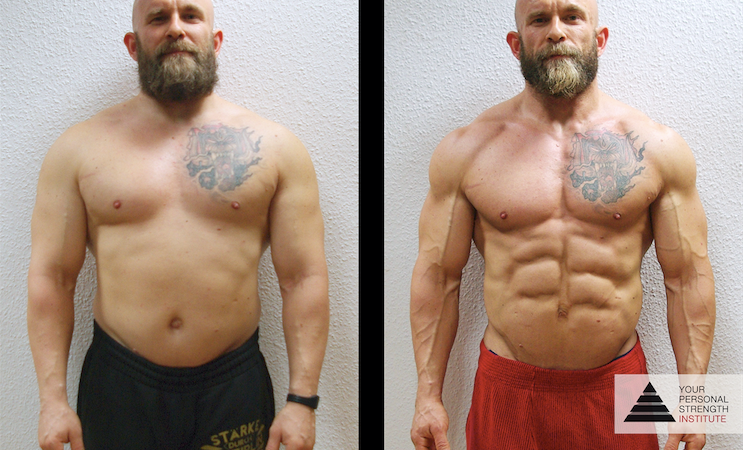
Peri-Workout Carb Loading Protocol for more Hypertrophy
Carbohydrates are neither bad nor good in general, they are both, in the right scenario.
So in simple terms, carbohydrates are your enemy if you don’t metabolize them properly. And carbohydrates are your friend if you metabolize them properly.
Many of my clients do best with a low-carb approach. Still, I consistently see clients that need carbohydrates to make progress. Especially when it comes to gaining size and hypertrophy as glycogen supercompensation is one of the primary mechanisms of hypertrophy.
What is glycogen supercompensation?
In sports science terms, supercompensation is the post training period during which the trained function/parameter has a higher performance capacity than it did prior to the training period. So glycogen supercompensation basically means depleting your glycogen stores through training and then filling the glycogen stores back up beyond the level before.
Glycogen supercompensation effect was first demonstrated in 1967 and then has become a very popular pre-event performance enhancing strategy for endurance sports. Endurance athletes potentially benefit from glycogen supercompensation because one factor affecting fatigue in events lasting longer than one hour is glycogen depletion.
In Strengthtraining and especially Bodybuilding benefit from glycogen supercompensation because each gram of glycogen is stored with 2,7 grams of water; therefore an increase in glycogen stores will draw fluid into the muscles. And as about 75% of muscle mass is fluid this a great way to increase muscle size and hypertrophy.
The Peri-Workout Carb Loading Protocol is an advanced approach to using carbohydrates to potentiate glycogen supercompensation and maximize to gain in muscle size and hypertrophy.
Yet, there are two primary prerequisites for this protocol to work properly:
1. You are carbohydrate-sensitive – two primary factors that make you carbohydrate-sensitive are low body fat and high muscle mass. Especially muscle mass plays a huge role is its the primary storage of glycogen and the Peri-Workout Carbohydrate Loading Protocol paired with a high volume training approach aims at maximizing glycogen super compensation. So if you are 80kg at 16% body fat this is not for you. If you are 100kg at 8% body fat and you want to pack on size apply it combined with point number 2 below.
2. Its done for a high volume workout – that means you have to do 200 and more reps in this workout. Compound exercises need to be primarily used for this to work. If you do 6 sets of 4-6 reps on biceps curls and triceps extension, this protocol will not have its intended effect as you overload the system with nutrients that it won’t properly metabolize. Shoot for a dense high-volume training system, preferably tri sets and giant sets to get the most out of Peri-Workout Carbohydrate Loading.
This is a sample protocol for a 100kg male for Peri-Workout Carbohydrate Loading.
Depending on the time of the day eat your regular meals before the peri-workout window.
2h before training
250g white fish or poultry
100g of rice
30min before training
50g of carbohydrate powder such as maltodextrin
12,5g of an amino-electrolyte-mix
Plenty of water
During training
50g of carbohydrate powder such as maltodextrin
12,5g of an amino-electrolyte-mix
Plenty of water
Right after training
200g of carbohydrate powder such as maltodextrin
75g of protein powder
1g of potassium citrate
300ml fruit juice, preferably from red fruits such as cherry, grape or black currant
Plenty of water
90min after training
250g white fish or poultry
200g of rice
Depending on the time of the day eat your regular meals after the peri-workout window.
This is an outstanding approach to add size fast when the two prerequisites above are in place.
The first time I have seen this approach to glycogen supercompensation to be used was in 2007 by Milos Sarcev around the time the documentary „Hungry like a Wolf“ was filmed (watch here).
The majority of systems that use glycogen supercompensation to increase hypertrophy and muscle size do this by following up days and even weeks of low carbohydrate consumption and higher training volume with a short period of high carbohydrate consumption. The main drawback of this approach is that recovery from training, sleep quality, training drive and gym performance will be impaired, if one sticks to a low carb approach for too long despite needing higher amounts of carbohydrates due to training volume, carbohydrate sensitivity and low glycogen stores. Using a peri-workout approach to glycogen supercompensation avoids the drawbacks of prolonged carbohydrate depletion of the classic glycogen supercompensation protocols such as impaired recovery from training, sleep quality, training drive and gym performance. While using acute depletion of a high volume workout combined with immediate replenishment of glycogen stores through maintaining a constant high blood sugar throughout and after the workout.
This is an excellent approach for an accumulation phase to maximize hypertrophy for moderate to advanced athletes with a high carbohydrate tolerance.
All the Best using Peri-Workout Carbohydrate Loading to add more Size!
To learn more about this protocol its variations and how to use carbohydrate to facilitate hypertrophy sign up for the YPSI Functional Nutrition for Bodybuilding & Strengthtraining Seminar in July this year, click here for more info
Click here to read another articles on my take on carbohydrate consumption – 2 Things I know for sure about Nutrition
Picture: YPSI Client Sven Knebel tolerates higher amounts of carbohydrates due to training volume, hypertrophy development and body fat level on the right compared to the left.
